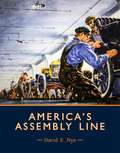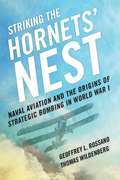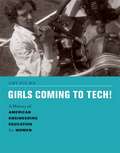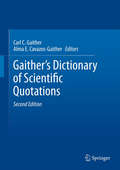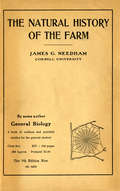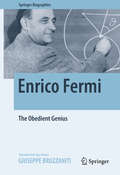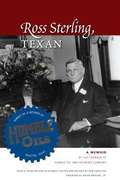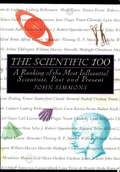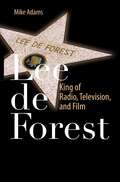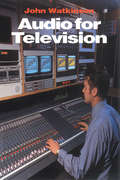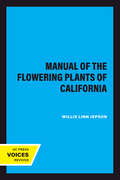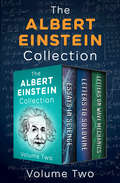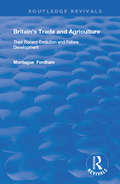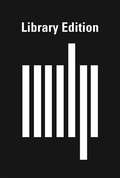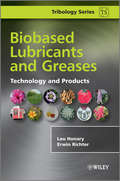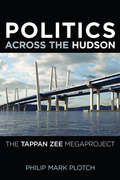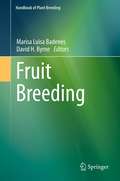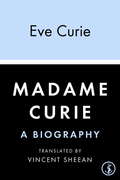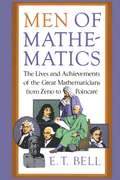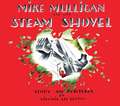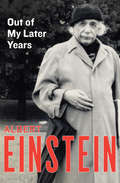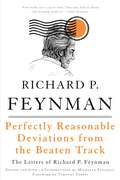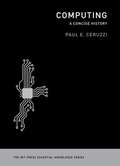- Table View
- List View
America's Assembly Line
by David E. NyeThe assembly line was invented in 1913 and has been in continuous operation eversince. It is the most familiar form of mass production. Both praised as a boon to workers andcondemned for exploiting them, it has been celebrated and satirized. (We can still picture Chaplin'slittle tramp trying to keep up with a factory conveyor belt. ) In America's AssemblyLine, David Nye examines the industrial innovation that made the United States productiveand wealthy in the twentieth century. The assembly line -- developed at the FordMotor Company in 1913 for the mass production of Model Ts -- first created and then served anexpanding mass market. It inspired fiction, paintings, photographs, comedy, cafeteria layouts, andcookie-cutter suburban housing. It also transformed industrial labor and provoked strikes and uniondrives. During World War II and the Cold War, it was often seen as a bastion of liberty andcapitalism. By 1980, Japan had reinvented the assembly line as a system of "leanmanufacturing"; American industry reluctantly adopted this new approach. Nye describes thisevolution and the new global landscape of increasingly automated factories, with fewer industrialjobs in America and questionable working conditions in developing countries. A century after Ford'spioneering innovation, the assembly line continues to evolve toward more sustainablemanufacturing.
Striking The Hornets' Nest: Naval Aviation And The Origins Of Strategic Bombing In World War I
by Geoffrey L. Rossano Thomas WildenbergStriking the Hornets’ Nest provides the first extensive analysis of the Northern Bombing Group (NBG), the Navy’s most innovative aviation initiative of World War I and one of the world’s first dedicated strategic bombing programs. Very little has been written about the Navy’s aviation activities in World War I and even less on the NBG. Standard studies of strategic bombing tend to focus on developments in the Royal Air Force or the U. S. Army Air Service. This work concentrates on the origins of strategic bombing in World War I, and the influence this phenomenon had on the Navy’s future use of the airplane. The NBG program faced enormous logistical and personnel challenges. Demands for aircraft, facilities, and personnel were daunting, and shipping shortages added to the seemingly endless delays in implementing the program. Despite the impediments, the Navy (and Marine Corps) triumphed over organizational hurdles and established a series of bases and depots in northern France and southern England in the late summer and early fall of 1918. Ironically, by the time the Navy was ready to commence bombing missions, the German retreat had caused abandonment of the submarine bases the NBG had been created to attack. The men involved in this program were pioneers, overcoming major obstacles only to find they were no longer needed. Though the Navy rapidly abandoned its use of strategic bombing after World War I, their brief experimentation directed the future use of aircraft in other branches of the armed forces. It is no coincidence that Robert Lovett, the young Navy reserve officer who developed much of the NBG program in 1918, spent the entire period of World War II as Assistant Secretary of War for Air where he played a crucial role organizing and equipping the strategic bombing campaign unleashed against Germany and Japan. Rossano and Wildenberg have provided a definitive study of the NBG, a subject that has been overlooked for too long.
Girls Coming to Tech!
by Amy Sue BixEngineering education in the United States was long regarded as masculine territory. For decades, women who studied or worked in engineering were popularly perceived as oddities, outcasts, unfeminine (or inappropriately feminine in a male world). In Girls Coming to Tech!, Amy Bix tells the story of how women gained entrance to the traditionally male field of engineering in American higher education. As Bix explains, a few women breached the gender-reinforced boundaries of engineering education before World War II. During World War II, government, employers, and colleges actively recruited women to train as engineering aides, channeling them directly into defense work. These wartime training programs set the stage for more engineering schools to open their doors to women. Bix offers three detailed case studies of postwar engineering coeducation. Georgia Tech admitted women in 1952 to avoid a court case, over objections by traditionalists. In 1968, Caltech male students argued that nerds needed a civilizing female presence. At MIT, which had admitted women since the 1870s but treated them as a minor afterthought, feminist-era activists pushed the school to welcome more women and take their talent seriously.In the 1950s, women made up less than one percent of students in American engineering programs; in 2010 and 2011, women earned 18.4% of bachelor's degrees, 22.6% of master's degrees, and 21.8% of doctorates in engineering. Bix's account shows why these gains were hard won.
Gaither's Dictionary of Scientific Quotations
by Carl C. Gaither Alma E. Cavazos-GaitherThis unprecedented collection of 27,000 quotations is the most comprehensive and carefully researched of its kind, covering all fields of science and mathematics. With this vast compendium you can readily conceptualize and embrace the written images of scientists, laymen, politicians, novelists, playwrights, and poets about humankind's scientific achievements. Approximately 9000 high-quality entries have been added to this new edition to provide a rich selection of quotations for the student, the educator, and the scientist who would like to introduce a presentation with a relevant quotation that provides perspective and historical background on his subject. Gaither's Dictionary of Scientific Quotations, Second Edition, provides the finest reference source of science quotations for all audiences. The new edition adds greater depth to the number of quotations in the various thematic arrangements and also provides new thematic categories.
Natural History of the Farm: A Guide to the Practical Study of the Sources of Our Living in Wild Nature
by James G. NeedhamThis is a guide to the practical study of the sources in wild nature of our living. It contains a series of study outlines for the entire year, and deals with both the plants and animals of the farm-the things that men have chosen to deal with as a means of livelihood and of personal satisfaction in all ages.
Enrico Fermi
by Giuseppe BruzzanitiThis biography explores the life and career of the Italian physicist Enrico Fermi, which is also the story of thirty years that transformed physics and forever changed our understanding of matter and the universe: nuclear physics and elementary particle physics were born, nuclear fission was discovered, the Manhattan Project was developed, the atomic bombs were dropped, and the era of "big science" began. It would be impossible to capture the full essence of this revolutionary period without first understanding Fermi, without whom it would not have been possible. Enrico Fermi: The Obedient Genius attempts to shed light on all aspects of Fermi's life - his work, motivation, influences, achievements, and personal thoughts - beginning with the publication of his first paper in 1921 through his death in 1954. During this time, Fermi demonstrated that he was indeed following in the footsteps of Galileo, excelling in his work both theoretically and experimentally by deepening our understanding of the Pauli exclusion principle, winning the Nobel Prize for his discovery of the fundamental properties of slow neutrons, developing the theory of beta decay, building the first nuclear reactor, and playing a central role in the development of the atomic bomb. Interwoven with this fascinating story, the book details the major developments in physics and provides the necessary background material to fully appreciate the dramatic changes that were taking place. Also included are appendices that provide a timeline of Fermi's life, several primary source documents from the period, and an extensive bibliography. This book will enlighten anyone interested in Fermi's work or the scientific events that led to the physics revolution of the first half of the twentieth century.
Ross Sterling, Texan: A Memoir by the Founder of Humble Oil and Refining Company
by Ed Kilman Ross S. SterlingBorn on a farm near Anahuac, Texas, in 1875 and possessed of only a fourth-grade education, Ross Sterling was one of the most successful Texans of his generation. Driven by a relentless work ethic, he become a wealthy oilman, banker, newspaper publisher, and, from 1931 to 1933, one-term governor of Texas. Sterling was the principal founder of the Humble Oil and Refining Company, which eventually became the largest division of the ExxonMobil Corporation, as well as the owner of the Houston Post. <P><P> Eager to "preserve a narrative record of his life and deeds," Ross Sterling hired Ed Kilman, an old friend and editorial page editor of the Houston Post, to write his biography. Though the book was nearly finished before Sterling's death in 1949, it never found a publisher due to Kilman's florid writing style and overly hagiographic portrayal of Sterling.
A Mathematician's Apology
by G. H. HardyG. H. Hardy was one of this century's finest mathematical thinkers, renowned among his contemporaries as a 'real mathematician … the purest of the pure'. He was also, as C. P. Snow recounts in his Foreword, 'unorthodox, eccentric, radical, ready to talk about anything'. This 'apology', written in 1940, offers a brilliant and engaging account of mathematics as very much more than a science; when it was first published, Graham Greene hailed it alongside Henry James's notebooks as 'the best account of what it was like to be a creative artist'. C. P. Snow's Foreword gives sympathetic and witty insights into Hardy's life, with its rich store of anecdotes concerning his collaboration with the brilliant Indian mathematician Ramanujan, his idiosyncrasies and his passion for cricket. This is a unique account of the fascination of mathematics and of one of its most compelling exponents in modern times.
The Scientific 100
by Simmons John LyndaWho are the great scientists throughout the ages, and what exactly did they do to earn their importance? From Archimedes to Newton to Einstein to Hawking, The Scientific 100 provides the fascinating answers. Vivid biographical sketches chronicle the lives and accomplishments of the world's preeminent scientists. And in the tradition of the Citadel Press 100 Series, they are ranked provocatively in order of influence--an inspiration for lively discussion. This unique volume is a browser's treasure trove and a handy reference for the general reader. John Simmons has been associated with Current Biography for more than fifteen years. He has written frequently about Nobel laureates in science. A member of the New York Academy of Sciences, he divides his time between New York City and Paris.
Lee de Forest
by Mike AdamsThe life-long inventor, Lee de Forest invented the three-element vacuum tube used between 1906 and 1916 as a detector, amplifier, and oscillator of radio waves. Beginning in 1918 he began to develop a light valve, a device for writing and reading sound using light patterns. While he received many patents for his process, he was initially ignored by the film industry. In order to promote and demonstrate his process he made several hundred sound short films, he rented space for their showing; he sold the tickets and did the publicity to gain audiences for his invention. Lee de Forest officially brought sound to film in 1919. Lee De Forest: King of Radio, Television, and Film is about both invention and early film making; de Forest as the scientist and producer, director, and writer of the content. This book tells the story of de Forest's contribution in changing the history of film through the incorporation of sound. The text includes primary source historical material, U.S. patents and richly-illustrated photos of Lee de Forest's experiments. Readers will greatly benefit from an understanding of the transition from silent to audio motion pictures, the impact this had on the scientific community and the popular culture, as well as the economics of the entertainment industry.
Turing's Legacy: Developments from Turing's Ideas in Logic
by Rod DowneyAlan Turing was an inspirational figure who is now recognised as a genius of modern mathematics. In addition to leading the Allied forces' code-breaking effort at Bletchley Park in World War II, he proposed the theoretical foundations of modern computing and anticipated developments in areas from information theory to computer chess. His ideas have been extraordinarily influential in modern mathematics and this book traces such developments by bringing together essays by leading experts in logic, artificial intelligence, computability theory and related areas. Together, they give insight into this fascinating man, the development of modern logic, and the history of ideas. The articles within cover a diverse selection of topics, such as the development of formal proof, differing views on the Church–Turing thesis, the development of combinatorial group theory, and Turing's work on randomness which foresaw the ideas of algorithmic randomness that would emerge many years later.
Audio for Television
by John WatkinsonAudio for Television outlinines all the relevant principles and practices. Newcomers to the field will find it an invaluable, up to date resource and experienced sound people will gain from the explanations of new technology. The rate of change in the technology of television sound has recently accelerated to such a degree that it is now a sufficiently expansive subject to warrant a book of its own. These rapid changes, from the introduction first of stereo, then multi-channel or surround sound, have made it difficult for those working in this field to keep up with the technology and even harder for those just setting out on a career in television sound.The book considers analog and digital audio as alternatives and stresses the advantages of both. Microphone and loudspeaker technology is also discussed in some detail and audio recording and routing and transmission are also covered.
A Manual of the Flowering Plants of California
by Willis Linn JepsonThis title is part of UC Press's Voices Revived program, which commemorates University of California Press’s mission to seek out and cultivate the brightest minds and give them voice, reach, and impact. Drawing on a backlist dating to 1893, Voices Revived makes high-quality, peer-reviewed scholarship accessible once again using print-on-demand technology. This title was originally published in 1925.
The Albert Einstein Collection Volume Two: Essays in Science, Letters to Solovine, and Letters on Wave Mechanics
by Albert EinsteinFrom revealing, personal letters to brilliant essays on the nature of science, these three volumes demonstrate the breadth of Einstein&’s thought. The man who became famous for conceiving of the equation E=mc2 kept his mind sharp through stimulating correspondence and applied his intellectual acuity to a number of important scientific issues. The second volume of the Albert Einstein Collection offers a fascinating window into how he developed his ideas. Essays in Science: In these sixteen essays, written at the height of his intellectual powers, Einstein sets out his views on scientific knowledge, its relationship to human experience, and the underlying principles of any scientific pursuit. He discusses his own work in theoretical physics and its basis in field theory, as well as the many achievements of other scientific thinkers—including Johannes Kepler, Isaac Newton, James Clerk Maxwell, Max Planck, Niels Bohr, and others. Letters to Solovine: This collection of personal letters from Einstein to his longtime friend and translator Maurice Solovine offers a rare glimpse into the evolution of his thought, as well as a revealing portrait of the man himself. Spanning Einstein&’s career and ranging from philosophical discussion to personal gossip, these letters are presented in English translation alongside the German text, with facsimiles of the original letters also included. Letters on Wave Mechanics: In this stirring collection of correspondence, four of the twentieth century&’s greatest minds—H. A. Lorentz, Max Planck, Erwin Schrödinger, and Albert Einstein—discuss, debate, and refine Schrödinger&’s then-nascent theory of wave mechanics. As the physicist Karl Przibram states in his foreword to this edition, &“little needs to be added to the letters; they speak for themselves. Apart from their essential content, they reveal something of the personalities of the four men of genius.&”
Britain's Trade and Agriculture: Their Recent Evolution and Future Development (Routledge Revivals)
by Montague FordhamPublished in 1932: The author in his Britain's Trade and Agriculture, though almost ruthlessly exposes the fallacies that lie behind the modern accepted views on industry and agriculture, though he obviously writes without desire to attract attention, but simply to clarify facts and to suggest practical solutions.
Innovation, Dual Use, and Security: Managing the Risks of Emerging Biological and Chemical Technologies
by Jonathan B. Tucker Richard DanzigRecent advances in disciplines such as biotechnology, nanotechnology, and neuropharmacology entail a "dual-use dilemma" because they promise benefits for human health and welfare yet pose the risk of misuse for hostile purposes. The emerging field of synthetic genomics, for example, can produce custom DNA molecules for life-saving drugs but also makes possible the creation of deadly viral agents for biological warfare or terrorism. The challenge for policymakers is to prevent the misuse of these new technologies without forgoing their benefits . Innovation, Dual Use, and Security offers a systematic approach for managing the dual-use dilemma. The book presents a "decision framework" for assessing the security risks of emerging technologies and fashioning governance strategies to manage those risks. This framework is applied to fourteen contemporary case studies, including synthetic genomics, DNA shuffling and directed evolution, combinatorial chemistry, protein engineering, immunological modulation, and aerosol vaccines. The book also draws useful lessons from two historical cases: the development of the V-series nerve agents in Britain and the use and misuse of LSD by the U. S. Army and the CIA. Innovation, Dual Use, and Security offers a comprehensive, multifaceted introduction to the challenges of governing dual-use technologies in an era of rapid innovation. The book will be of interest to government officials and other practitioners as well as to students and scholars in security studies, science and technology studies, biology, and chemistry.
Biobased Lubricants and Greases
by Lou Honary Erwin RichterDue to the rise in petroleum prices as well as increasing environmental concerns, there is a need to develop biochemicals and bioproducts that offer realistic alternatives to their traditional counterparts; this book will address the lack of a centralized resource of information on lubricants and greases from renewable sources, and will be useful to a wide audience in industry and academia. It is based on 20 years of research and development at the UNI-NABL Center, and discusses the various types of vegetable oils available, comparing their characteristics, properties and benefits against those of typical petroleum oils as well as discussing common evaluation tests and giving examples and case studies of successful applications of biobased lubricants and greases. Whilst scientific and engineering research data is included, the book is written in an accessible manner and is illustrated throughout. Focuses on an industrial application of lubrication technology undergoing current explosive growth in the global market.Includes a detailed review of the material benefits of plant-based lubricants that include a better viscosity index and lubricity even at extreme temperatures, lower flammability due to higher flash points and lower pour points.Covers the basic chemistry of vegetable oils as well as their profiles for use in lubricants and greases and environmental benefits.Includes examples and case studies of where vegetable-based lubricants have been successfully employed in industry applications.
Politics Across the Hudson
by Philip Mark PlotchThe State of New York is now building one of the world's longest, widest, and most expensive bridges--the new Tappan Zee Bridge--stretching more than three miles across the Hudson River, approximately thirteen miles north of New York City. In Politics Across the Hudson, urban planner Philip Plotch offers a behind-the-scenes look at three decades of contentious planning and politics centered around this bridge. He reveals valuable lessons for those trying to tackle complex public policies while also confirming our worst fears about government dysfunction. Drawing on his extensive experience planning megaprojects, interviews with more than a hundred key figures--including governors, agency heads, engineers, civic advocates, and business leaders--and extraordinary access to internal government records, Plotch tells a compelling story of high-stakes battles between powerful players in the public, private, and civic sectors. He reveals how state officials abandoned viable options, squandered hundreds of millions of dollars, forfeited more than three billion dollars in federal funds, and missed out on important opportunities. Faced with the public's unrealistic expectations, no one could identify a practical solution to a vexing problem, a dilemma that led three governors to study various alternatives rather than disappoint key constituencies. Politics Across the Hudson continues where Robert Caro's The Power Broker left off and illuminates the power struggles involved in building New York's first major new bridge since the Robert Moses era. Plotch describes how one governor, Andrew Cuomo, shrewdly overcame the seemingly insurmountable obstacles of onerous environmental regulations, vehement community opposition, insufficient funding, interagency battles, and overly optimistic expectations.
Fruit Breeding
by Maria Luisa Badenes David H. ByrneFruit Breeding is the eighth volume in the Handbook of Plant Breeding series. Like the other volumes in the series, this volume presents information on the latest scientific information in applied plant breeding using the current advances in the field, from an efficient use of genetic resources to the impact of biotechnology in plant breeding. The majority of the volume showcases individual crops, complemented by sections dealing with important aspects of fruit breeding as trends, marketing and protection of new varieties, health benefits of fruits and new crops in the horizon. The book also features contributions from outstanding scientists for each crop species. Maria Luisa Badenes Instituto Valenciano de Investigaciones Agrarias (IVIA), Valencia, Spain David Byrne Department of Horticultural Sciences, Texas A&M University, College Station, TX, USA
Madame Curie: A Biography (Da Capo Series In Science)
by Eve CurieMarie Sklodowska Curie (1867-1934) was the first woman scientist to win worldwide fame, and indeed, one of the great scientists of this century. Winner of two Nobel Prizes (for physics in 1903 and for chemistry in 1911), she performed pioneering studies with radium and contributed profoundly to the understanding of radioactivity. The history of her story-book marriage to Pierre Curie, of their refusal to patent their processes or otherwise profit from the commercial exploitation of radium, and her tragically ironic death are legendary and well known but are here revealed from an inside perspective. But, as this book reveals, it was also true. An astonishing mind and a remarkable life are here portrayed by Marie Curie’s daughter in a classic and moving account.
Men of Mathematics
by E. T. BellHere is the classic, much-read introduction to the craft and history of mathematics by E.T. Bell, a leading figure in mathematics in America for half a century. Men of Mathematics accessibly explains the major mathematics, from the geometry of the Greeks through Newton's calculus and on to the laws of probability, symbolic logic, and the fourth dimension. In addition, the book goes beyond pure mathematics to present a series of engrossing biographies of the great mathematicians -- an extraordinary number of whom lived bizarre or unusual lives. Finally, Men of Mathematics is also a history of ideas, tracing the majestic development of mathematical thought from ancient times to the twentieth century. This enduring work's clear, often humorous way of dealing with complex ideas makes it an ideal book for the non-mathematician.
Mike Mulligan and His Steam Shovel
by Virginia Lee BurtonMike and his trusty steam shovel, Mary Anne, dig deep canals for boats to travel through, cut mountain passes for trains, and hollow out cellars for city skyscrapers -- the very symbol of industrial America. But with progress come new machines, and soon the inseparable duo are out of work. Mike believes that Mary Anne can dig as much in a day as one hundred men can dig in a week, and the two have one last chance to prove it and save Mary Anne from the scrap heap. What happens next in the small town of Popperville is a testament to their friendship, and to old-fashioned hard work and ingenuity.
Out of My Later Years: The Scientist, Philosopher, and Man Portrayed Through His Own Words
by Albert EinsteinAn inspiring collection of essays, in which Albert Einstein addresses the topics that fascinated him as a scientist, philosopher, and humanitarian Divided by subject matter—&“Science,&” &“Convictions and Beliefs,&” &“Public Affairs,&” etc.—these essays consider everything from the need for a &“supranational&” governing body to control war in the atomic age to freedom in research and education to Jewish history and Zionism to explanations of the physics and scientific thought that brought Albert Einstein world recognition. Throughout, Einstein&’s clear, eloquent voice presents an idealist&’s vision and relays complex theories to the layperson. Einstein&’s essays share his philosophical beliefs, scientific reasoning, and hopes for a brighter future, and show how one of the greatest minds of all time fully engaged with the changing world around him. This authorized ebook features rare photos and never-before-seen documents from the Albert Einstein Archives at the Hebrew University of Jerusalem.
Perfectly Reasonable Deviations From the Beaten Track: The Letters of Richard P. Feynman
by Richard P. FeynmanA Nobel Prize-winning physicist, a loving husband and father, an enthusiastic teacher, a surprisingly accomplished bongo player, and a genius of the highest caliber---Richard P. Feynman was all these and more. Perfectly Reasonable Deviations From the Beaten Track--collecting over forty years' worth of Feynman's letters--offers an unprecedented look at the writer and thinker whose scientific mind and lust for life made him a legend in his own time. Containing missives to and from such scientific luminaries as Victor Weisskopf, Stephen Wolfram, James Watson, and Edward Teller, as well as a remarkable selection of letters to and from fans, students, family, and people from around the world eager for Feynman's advice and counsel, Perfectly Reasonable Deviations From the Beaten Track not only illuminates the personal relationships that underwrote the key developments in modern science, but also forms the most intimate look at Feynman yet available. Feynman was a man many felt close to but few really knew, and this collection reveals the full wisdom and private passion of a personality that captivated everyone it touched. Perfectly Reasonable Deviations From the Beaten Track is an eloquent testimony to the virtue of approaching the world with an inquiring eye; it demonstrates the full extent of the Feynman legacy like never before. Edited and with additional commentary by his daughter Michelle, it's a must-read for Feynman fans everywhere, and for anyone seeking to better understand one of the towering figures--and defining personalities--of the twentieth century.
Computing
by Paul E. CeruzziThe history of computing could be told as the story of hardware and software, or the story of the Internet, or the story of "smart" hand-held devices, with subplots involving IBM, Microsoft, Apple, Facebook, and Twitter. In this concise and accessible account of the invention and development of digital technology, computer historian Paul Ceruzzi offers a broader and more useful perspective. He identifies four major threads that run throughout all of computing's technological development: digitization--the coding of information, computation, and control in binary form, ones and zeros; the convergence of multiple streams of techniques, devices, and machines, yielding more than the sum of their parts; the steady advance of electronic technology, as characterized famously by "Moore's Law"; and the human-machine interface. Ceruzzi guides us through computing history, telling how a Bell Labs mathematician coined the word "digital" in 1942 (to describe a high-speed method of calculating used in anti-aircraft devices), and recounting the development of the punch card (for use in the 1890 U. S. Census). He describes the ENIAC, built for scientific and military applications; the UNIVAC, the first general purpose computer; and ARPANET, the Internet's precursor. Ceruzzi's account traces the world-changing evolution of the computer from a room-size ensemble of machinery to a "minicomputer" to a desktop computer to a pocket-sized smart phone. He describes the development of the silicon chip, which could store ever-increasing amounts of data and enabled ever-decreasing device size. He visits that hotbed of innovation, Silicon Valley, and brings the story up to the present with the Internet, the World Wide Web, and social networking.
